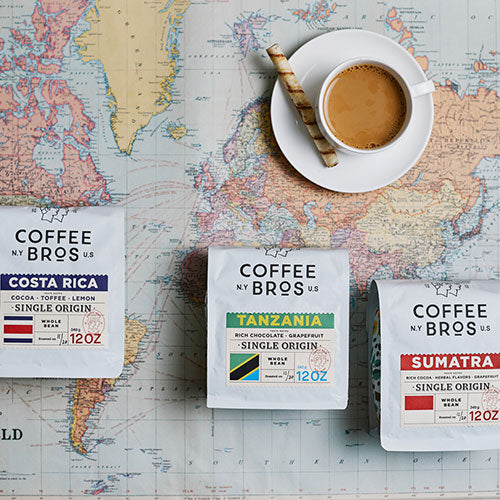How to Store SOE Single Origin Espresso for Optimal Freshness
Exploring the Abundant Tastes of Coffee Beans: a Deep Study Espresso and Blended Coffee Beans
When you discover the abundant tastes of coffee beans, you reveal a complicated world where each variety brings its very own character to your mug. As you navigate through the art of coffee and the imagination behind blended coffees, you'll start to appreciate the nuances that make each sip distinct.
The Beginnings of Coffee Beans: Checking Out Terroir and Flavor Profiles
When you take a sip of coffee, you're not simply delighting in a drink; you're experiencing an abundant tapestry of flavors formed by the beans' origins. Each area produces special flavor accounts influenced by environment, altitude, and dirt. As an example, beans from Ethiopia often rupture with bright, fruity notes, while those from Colombia have a tendency to offer a well balanced, nutty sweet taste.
As you explore different beginnings, you'll discover just how terroir-- the environmental aspects influencing a crop-- plays an essential function - Single Origin Espresso. The very same coffee range can taste significantly various depending on where it's grown
When you take into consideration these aspects, you begin to value the complexity behind your cup. Each sip informs a story of the land and the farmers that nurtured the beans. Following time you indulge, assume about the trip your coffee took prior to it reached your hands, and enjoy those elaborate flavors that show its beginning.
Recognizing Coffee: The Art and Science Behind the Mixture
When you think of espresso, it's not practically the solid flavor; it's additionally about the strategies that bring it to life. Recognizing exactly how different preparation methods effect taste can change your developing experience. Allow's check out the ins and outs of espresso preparation and reveal the one-of-a-kind taste accounts that make each cup unique.
Coffee Preparation Techniques
Coffee prep work is both a science and an art, combining specific methods with a deep understanding of coffee. To start, you'll want to pick top quality, freshly baked beans and grind them carefully for suitable extraction (Single Origin Espresso). The grind dimension is essential; also crude, and your espresso will be weak, also great, and it'll be bitter
Following, tamp the premises uniformly in the portafilter to guarantee consistent extraction. When you secure it into the machine, purpose for a developing temperature in between 190 ° F and 205 °
F.As you pull the shot, expect the ideal removal time-- around 25-30 seconds. The outcome ought to be an abundant, velvety coffee with an attractive layer of crema on the top. With practice, you'll grasp these techniques.
Taste Profiles Described
The globe of espresso provides a rich tapestry of taste accounts that can elevate your coffee experience. Light roasts typically display intense acidity and dynamic flavors, while dark roasts existing much deeper, bolder tones.
A well-crafted blend may balance the brilliant notes of an Ethiopian bean with the abundant, chocolatey touches of a Brazilian bean. Accept the journey of discovering espresso's diverse tastes, and you'll transform your coffee ritual into an interesting experience.
Handling Methods: Just How They Impact Taste and Fragrance
While it may seem that the origin of coffee beans is the most substantial element in identifying their flavor and scent, the handling techniques utilized post-harvest play an equally important role. You'll find that these methods can considerably modify the final taste profile of your mug.
As an example, the washed process removes the fruit from the beans prior to fermentation, typically resulting in a cleaner, brighter taste. The natural procedure leaves the fruit intact throughout drying, resulting in a sweeter, fruitier account.
Various other techniques, like honey handling, strike a balance, permitting some fruit mucilage to stay, providing an one-of-a-kind complexity.
Each handling technique engages with the beans' inherent attributes, enhancing or silencing specific flavors and fragrances. When you drink that coffee or blended coffee, keep in mind that the trip from cherry to mug is influenced not simply by beginning but additionally by how those beans were processed.
Roasting Strategies: Unlocking the Full Prospective of Coffee Beans
Roasting techniques are vital for disclosing the full capacity of coffee beans, as they change raw, environment-friendly beans into the aromatic, delicious coffee you enjoy. The option of toasting approach-- light, tool, or dark-- considerably affects flavor profiles. Light roasts protect the beans' natural level of acidity and fruity notes, while medium roasts equilibrium sweet taste and richness. Dark roasts, on the other hand, stress strong, great smoky tastes.
You can experiment with roasting temperature levels and times to locate your excellent mixture. A slower roast at reduced temperatures allows for complex flavors to develop, while a quicker roast can intensify bitterness. Focus on the splits throughout toasting; the very first fracture suggests a light roast, while the second crack signals a dark roast. By understanding these strategies, you'll disclose a globe of flavor, elevating your coffee experience to new elevations. Enjoy every sip, click here to find out more recognizing the treatment that entered into your cup!
The Magic of Blended Coffee: Producing Special Taste Experiences
Producing an one-of-a-kind flavor experience with blended coffee can change your early morning routine right into an exploration of taste. By combining different beans from numerous areas, you can disclose a harmony of flavors that elevate your mug to new elevations. Each mix offers a distinct profile, stabilizing acidity, body, and sweet taste to produce something truly unique.
When you pick a blend, you're not simply picking a coffee; you're choosing a journey across varied landscapes and cultures. Trying out various combinations permits you to discover your personal faves, whether you delight in fruity notes or abundant, chocolatey undertones.

Sampling Notes: Recognizing the Nuances in Your Mug
As you drink your coffee, you might observe a range of flavors dancing on your taste buds, each revealing the ins and outs of the beans. You might taste the bright acidity similar to citrus or the deep, abundant notes comparable to dark chocolate. The sweetness can stimulate honey or caramel, balancing the general account wonderfully.
Take note of the body of the coffee-- does it feel ventilated and light, or is it full and creamy? The surface, also, provides hints; a remaining aftertaste might mean nuttiness or flower touches.

Don't forget to explore the unique characteristics of various beginnings, as each region passes on distinct flavors - Single Origin Espresso. For example, Ethiopian coffees usually existing fruity notes, while Colombian beans could showcase a much more rounded sweet taste. By acknowledging these nuances, you'll deepen your admiration for every cup, boosting your coffee experience to new heights

Brewing Methods: Making The Most Of Flavor Removal for each Bean
When you explore the numerous brewing methods, you'll uncover that each method can considerably impact the taste profile of your coffee. From French press to pour-over, each approach removes different substances, improving or muting details notes. Making use of a French press enables oils to stay in the brew, producing a richer preference, while pour-over stresses quality and illumination.
Temperature level and grind dimension likewise play crucial duties. Bonuses A coarser work functions best for chilly mixtures, while a great grind is perfect for coffee. Try out water temperature level-- between 195 ° F and 205 ° F-- can reveal concealed flavors, as well.
Do not ignore soaking time; a quick extraction can bring about sour notes, while over-extraction may produce anger. By changing these variables, you can take full advantage of taste extraction and really boost your coffee experience. Enjoy the journey of finding what approach best fits your taste!
Regularly Asked Questions
What Is the Suitable Water Temperature Level for Developing Coffee?
The perfect water temperature level for developing coffee's in between 195 ° F and 205 ° F. If you use water that's too hot, you'll over-extract flavors; as well cool, and you will not extract sufficient. Go for that pleasant spot for the finest mixture!
How Does Work Size Impact Coffee Taste?
Work dimension substantially impacts coffee taste. Better grinds essence extra flavors and oils, resulting in a bolder taste, while coarser grinds yield a lighter flavor. Changing grind size helps you accomplish your desired coffee profile.
Are There Health And Wellness Conveniences Associated With Drinking Coffee?

What Is the Difference In Between Arabica and Robusta Beans?
Arabica beans are smoother and sweeter, usually including fruity tastes, while robusta beans are stronger with a bitter taste and greater high levels of caffeine material. You'll discover these differences in fragrance and developing experience.
Exactly How Can I Store Coffee Beans for Freshness?
To keep coffee beans for quality, maintain them in an impermeable container, far from wetness, light, and heat. You'll maintain their taste much longer if you only grind what you need right prior to brewing.
Exploring the Rich Tastes of Coffee Beans: a Deep Dive Into Espresso and Blended Coffee Beans.
When you explore the rich flavors of coffee beans, you discover a complex world where each selection brings its own personality to your cup.When you take a sip of coffee, you're not just taking pleasure in a drink; you're experiencing an abundant tapestry of flavors formed by the beans' origins.Roasting strategies are crucial for disclosing the full possibility of coffee beans, as they transform raw, green beans right into the fragrant, delicious coffee you enjoy.As you drink your coffee, you might observe a range of flavors dancing on your taste, each disclosing the intricacies of the beans.